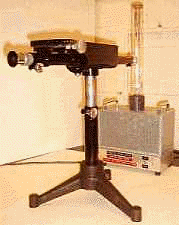




You will do just a few of the 48 experiments existing in the First Year Physics Laboratory!
 |
Students in PHY110Y and PHY138Y will complete several required modules during the Fall term. You can choose from either the core or non-core
experiments during the Spring term. To help your three person subgroup
make selections, read the following brief
descriptions of the experiments. The complete guide sheets to some
experiments are
included below. You can print out individual pages as required by your
subgroup. Exp1 -
Curved Air Track, The Air
Table, The Flywheel (complete guide sheet), The Torsion Pendulum, The
Gyroscope, Oscillations of a Sphere on a Concave Surface, The
Wilberforce Spring, Boyle's
Law, Surface Tension, Viscosity of Water by Capillary Flow Exp2 - Heat
Capacity (complete
guide sheet), Thermal Expansion, Vapour Pressure of Water (complete
guide sheet), Absolute Zero (complete guide sheet) Exp3 - The
Mechanical Equivalent
of Heat, DC Circuits (complete guide sheet), Thermistors and Diodes,
The Electrocardiogram, Digital Electronics, Charge and Discharge of a
Capacitor, Faraday's Law and the AC Generator Exp4 - Lens
Optics, Physics of
Sound, The Acoustic Interferometer, The Speed of Sound in a Solid
(complete guide sheet), Standing Waves and Acoustic Resonance, The
Speed of Sound in a Pure Gas Exp5 -
Interference and
Diffraction (Using a Laser), Refraction of Light, Microwave Optics,
Optical Activity,
Electron Diffraction, Optical Fibers, Spectra, Gamma-Ray Spectra,
Radioactivity in the Air, Scattering, X-Ray
and Gamma-Ray Absorption in Matter, e/m for an Electron, The Speed of
Light, The Cavendish Experiment, The Millikan Oil-Drop Experiment,
Echolocation by Ultrasound |
|
Spectra |
|
Talented and/or interested students are encouraged to consider the non-core experiments and especially the "two weight" ones, which are often more difficult and more interesting than the one weight ones. Classic experiments to measure fundamental constants such as e/m for an electron, the speed of light, and the universal gravitational constant or to prove the quantification of the electric charge are among the non-core set. Students can also consider various experiments investigating wave phenomena or atomic and nuclear physics.
|
|
|
e/m for an electron |
We encourage students to do any experiment in the lab as a substitute for one or more core experiments. A free-choice experiment can be either from the core
or non-core set.